
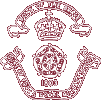

 |
 |
|
 |
||
| Navigation links at the bottom of this page | ||||||||
| 1946 Return to Dover | ||||||||
Obvious signs of war and devastation greeted Dukies returning to Dover in 1946. Frank Hartry, joined the school at the beginning of the same term that the older boys returned from the wartime evacuation. Remembering this time, he said, "Large sections of Dover , especially along the sea front, were still looking gaunt and bombed-out when I first set eyes on the town. Dover 's wartime name of 'Hell's fire corner' was entirely appropriate. The school was dotted with air-raid shelters and Roberts House was in ruins, but whether from the effects of a German shell from across the Channel or the result of a fire I never did find out." Roberts House was not restored to its original state during his time at the school from 1946 to 1951. The possibility was remote of anyone returning to Dover from its evacuation first to Cheltenham and then to North Devon who experienced school life before the war was remote. One who did fall into this category was Peter Cartwright, who joined the school in 1939 and returned from Saunton as chief school prefect. (Gazetted in 1948, Lieut. Peter Cartwright of the Royal Scots Fusiliers died in Malaya attempting to rescue a fellow soldier in difficulty in deep water. His death was reported in the July 1953 issue of The Chronicle.) The need for skilled tradesmen in the Army during the war years meant that boys were transferred to the apprentice training schools as fast as they could be persuaded to sign on for regular service: seven years with the colours, and five with the reserve. It is against this background of school life before the war, the haphazard life of those during the evacuation, and the return to Dover that the changes during the first ten years after WWII must be equated. These changes included a new approach to staffing, the education curriculum, the uniforms worn and the greater emphasis placed on providing a 'public school' atmosphere in contrast to the heavy accent on the school's traditional beat of the military drum. |
||||||||
Housemasters and staffing The most obvious and immediate change to anyone familiar with the pre-war regime was the introduction of housemasters. Not every house had a housemaster and family in residence when those evacuated returned. Roger Foley, who had been evacuated as a civilian from the family home in Kent to Cornwall with his sister, entered the school for one term before its return to Dover . Roger was in Wolfe House with a Captain Banks and his wife in residence. Mrs. Banks, he recalls, took an interest in the boys and did a nightly tour of inspection. The same could not be said of wives of other housemasters, for many of them were not seen from one day to the next. Frank Hartry spent his first year in Haig, the house for junior boys, still under the administrative care of a CSM Justice. A commissioned officer housemaster was not provided for Haig until May 1947, which raises an interesting question. Why were housemasters introduced? One explanation is that, with the return to peace and a likely shortage of work, the introduction of housemasters was one means of providing ex-officers with employment. A more likely explanation, however, is that 'housemasters' with a background in education (most were RAEC) was a positive step in raising the standard of education to provided. Housemaster Norman Tritton was ex-RAF and a civilian by the time he joined the school. CSMs, responsible to the housemasters once the latter were in residence, had charge of what used to be known as trades training. Cobbling, tailoring, signalling and gunnery drill were replaced by 'military training' for which proficiency badges were issued. Music remained a major part of school life with a vibrant and active band and separate drum corps, which was often combined as shown in the following photograph. Meanwhile, the housemasters, who were either RAEC or civilians, took on the role of disciplinarians. Frank Hartry recalls that he transferred from Haig to Wolsely in May 1947 under Housemaster Captain Ritson, RAEC. Ritson wore civilian clothes and lived in the house accommodation with his wife and daughter. Unlike other housemasters or most of the old CSMs, who were mostly tolerant old soldiers who allowed the boys slack, Ritson administered the cane with gay abandon every evening in the day room on boys who had, during the day, incurred his wrath. Frank relates that "Fritz loved his cane ... A toothbrush out of line on a kit inspection was enough for a few strokes." |
||||||||
The combined band and drum corps (c 1949) before the battledress blouses and long trousers replaced the old style uniform. |
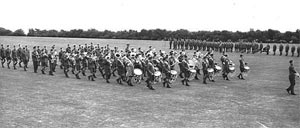 |
|||||||
Describing the combined formation of the band and drums, Roger Foley wrote, "The Corps of Drums, known as 'The Drums' had the Drum Major, a front rank of seven side-drummers, a second rank made up of two tenor drummers (leopard skins) and the bass drummer and then four ranks of buglers-flute players for a total of thirty-nine. The Band had eight ranks of seven but their bass drummer was pushed forward to march alongside our bass drummer. For big parades such as the trooping of the colour, the two formations were combined for a total of ninety-five and was called 'The Band and Drums'. In the photo the drummer third from the left has dropped back a bit and makes it look as if there were only six files. The last four ranks at the back are all buglers. You can see the two bass drummers side by side. Foley was leading side-drummer for three years." The day dress of the Regimental Sergeant Major and the CSMs was identical to the pre-war dress of the British Army except that puttees had never been worn. The RSM wore a barathea uniform similar to the dress of commissioned ranks that permitted the use of the Sam Browne waist belt, shoulder strap and ceremonial sword. RSM Jones, ex-Grenadier Guards, had joined the school pre-war along with a number of the CSMs including Justice and Halsey. During this period of change that saw the introduction of housemasters, CSMs, who travelled about the school on bicycles, were accommodated in staff quarters near the Guston Gate. They were responsible for rifle shooting, field craft, drill, and music with the band and corps of drums. CSM Bill (Jam) Fry, who joined the school at Saunton Sands in 1942 from the Devonshire Regiment, had both Kitchener and Wolsely houses under his musical instruction and guidance. He was the assistant bandmaster and frequently marched in the ranks of the band, playing his instrument, the B flat clarinet. Ken Smith recalls that CSM Jan Fry, "... was a born teacher of musical instruments. Smith began learning the trombone and euphonium until he was changed to the percussion section because of an illness. His instrument, the bass drum. Under civilian Bandmaster Singer, the school band became a pre-eminent music assembly during the post-war period. It frequently performed marching engagements around the towns and cities of Kent and often performed on the BBC's 'Music while you work' programme. CSM Halsey had charge of Marlborough and Wolfe houses under their respective housemasters. He managed the drum corps, which included the buglers. Buglers also played the flute. Halsey had a great sense of humour and was devoted to his vocation even though he had a quick temper at times. "At evening band practice," as Frank Hartry who played the flute and bugle attests, "he would let you have it across the seat of your pants if he thought you were wasting the period by not paying attention." Hartry was one of the buglers required to play reveille, to call everyone to the dining room and to send them to bed with 'the last post'. Bugle calls figured prominently in the life of the post-war school. CSM Lowrie was responsible for Clive and Wellington houses under their housemasters. A war time newcomer to the staff, Lowrie taught the boys of Clive and Wellington military subjects such as rifle marksmanship and military certificates A and B. One striking feature of school life has prevailed throughout the institution's long history. This has been the care taken by the authorities to protect its charges from the predatory attention of pedophiles. Sexual molestation is not a pleasant subject for discussion one will readily agree. At the same time, the subject is no longer swept under the rug, for the care of their children entrusted to the school authorities is of deep concern to parents. In this regard, from its inception, the institution has maintained a remarkable record free from the stigma of sexual scandal between staff of their young charges. Questioned on this subject during an interview in 1982, CSM Bill Fry was of the opinion that the school had always employed married senior staff. If the boys were well-protected from the attention of predatory adults, the same could not be said of unwanted attention from fellow students. This had always been a matter of concern to the authorities. Between 1948 and 1950 an investigation was conducted of sexual interference by senior boys of younger boys in some houses. The houses in question are not of importance here. Nevertheless, the investigation exposed a substantial number of incidents involved as many as fifteen senior boys and prefects, who were summarily expelled. One correspondent, whose information was confirmed by others, wrote, "I well remember a pale-faced distraught Commandant, Lt. Col. R. E. Barnwell, standing on the stage in the school assembly one morning and telling us boys what a disgrace the expelled boys had brought to the school. Uniforms Returned to Dover , boys retained their pre-war khaki uniform, which had been in use for the past thirty years. This was the single-breasted khaki tunic with five medium-sized brass buttons down the front with a single button to secure the flaps of breast pockets. The tunic was a throat choker to the neck. They wore short, khaki trousers; khaki stockings to just below the knees; black leather boots with studs; and a forage cap with two brass buttons at the front. On the left side of the cap, boys wore the school cap badge. Their heavy coat for inclement weather was a single-breasted great coat with large brass buttons down the front. |
||||||||
Commissioned officers and senior non-commissioned ranks wore the barathea wide-pocket uniform, sergeant prefects pre-war dress and boys the standard old-style uniform |
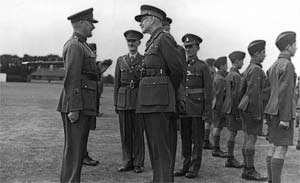 |
|||||||
Some things had changed since the pre-war dress. The red infantry-style coat and long blue trousers with red piping down the sides was a uniform no longer issued. Black shoes were in use for walking out; a khaki jersey or sweater; and an ground sheet for use in rainy weather. For physical training and gym work, the wear was a pair of black or dark blue shorts, a white singlet and plimsoles. Frank Hartry reports that PT shorts "... were sometimes worn as uniform shorts with the matron's written permission if one's khaki shorts were in for repair, so one would often see mixed dress by some of the boys during their daily routine." At the turn of the 1950s, boys exchanged their pre-war uniforms and forage caps for a khaki battle dress blouse and khaki beret. They still had brass buttons enough to require the use of button sticks. The button stick was a brass template that permitted one to clean the buttons with a brass cleaner without staining the khaki fabric. The change to new uniforms was not universal and immediate, but took place gradually. Only the taller boys were issued with long trousers. Shorter boys continued wearing khaki shorts and long hose stockings with their new battledress blouse tops. David Leigh-Howarth recalled that "... you remained in short trousers until you were 5' 3"." |
||||||||
In contrast with pre-war practice, when boys had four uniforms, two khaki and two red ceremonial dress, students of the post-war era had two khaki uniforms only: one for everyday wear, the second for church parades and special occasions. There were no electric irons to crease one's trousers.
Creases were maintained by wetting the crease lines and pressing them into position between cardboard under the bed. On parade, boys wore their fathers' medals on the right breast and his regimental cap badge on the front of the tunic. |
Group photograph of Clive house 1950 | 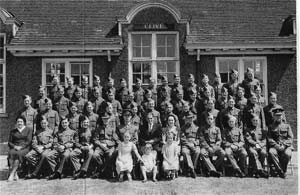 |
||||||
Photos show the changeover in dress from the pre-war uniform to battledress. Note the short trousers and battledress top worn by the younger boys. |
||||||||
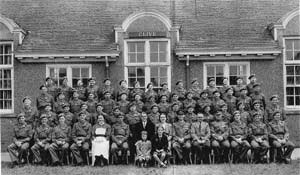 |
||||||||
| Group photograph of Clive house 1951 | ||||||||
Group photo of Kitchener house 1953
|
||||||||
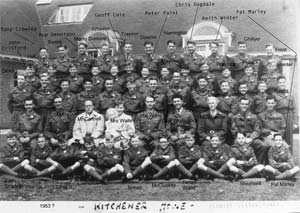 |
||||||||
Later, however, grey flannel trousers and blue blazers with the 'white rose' blazer badge on the left hand breast pocket were issued. When first introduced, parents had to pay for the blazer, which could then be worn when walking out or for sports functions. Later, the combination grey flannel trousers and blazer were adopted for daily wear, but not until the nineteen mid-fifties. The combination, grey flannels and blazers, was an additional suit to the two uniforms. |
||||||||
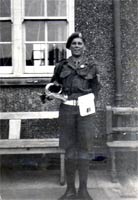 |
Left: |
|
Right: |
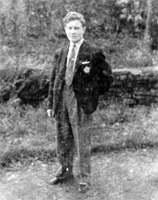 |
||||
A fundamental change in army education at the school occurred when the old third, second, first and special certificates (in ascending order of importance) were discarded and the national curriculum was adopted to meet national standards and to prepare boys to a university entrance level of education. The main source of teaching staff in the post-war period was still the Royal Army Education Corps although civilian teachers were introduced. A Miss Blackman taught all subjects in Haig junior house, her instruction being given almost opposite Haig in a wooden structure that later became a practice room for the corps of drums. The school education system recognized three grades or streams of learning designated G, T and M respectively. G for grammar was for those who left the school at age 18 to enter the Royal Military College, Sandhurst, or university. T was for the 'technical' stream and M for the 'modern' stream who left the school at 15 or 16 to enter and army apprentice school or boy service in, for example, as a musician in a military band. |
||||||||
A notable personality One correspondent recalls three chaplains of whom, the first was the Rev. Neville Metcalf DSO, BA (945-48) followed by Chaplain Haynes (948-51), "...a totally different, blustering fellow..." and, finally, Chaplain Burnham (1953-61), "...a quiet, very introspective man who was a suitable replacement for Haynes." Roger Foley recalled Chaplain Metcalf as a charismatic personality who had served with distinction in the Burma Campaign. He attended the wounded, the sick and the dying during the retreat, often risking his life to do so under Japanese fire. In 1942, he was posted to North Africa where he remained with the 8th Army during its long desert campaign. Metcalf is remembered as a sporting, humorous, gentle and understanding man who delivered spell-binding sermons and had a fund of thought-provoking stories about religion and WWII. He brought the Sunday evening church service to life with provocative films about the nuclear bomb and its devastating after-effect. Brig. Smyth VC mentions Metcalf a number of times in his account of the retreat in Burma , bearing testimony to his remarkably brave war record. Roger believes that Metcalf eventually became Chaplain-General to the British Army. Conclusion Such were the changes that took place once the school returned to Dover to occupy the premises vacated for the duration of the war. Sincere thanks are extended to all those who responded to the survey and offered their recollections. |
||||||||
| ||||||||||
|
© A. W. Cockerill 2011 Site Map Contact me | ||||||||||